The tiny black bugs in the plant soil can be difficult to identify with the naked eye as they are so minute that some of the fully-grown black bugs are even less than 0.04 inches long.
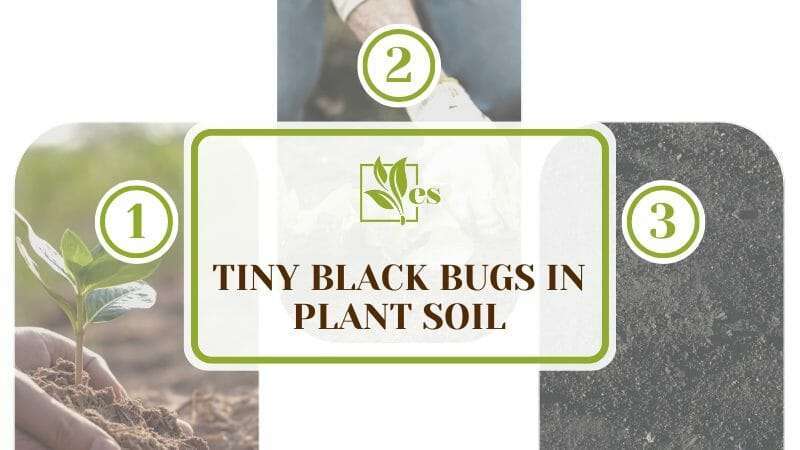 You can easily do soil bugs identification through the damage that they cause to the plant, as some bugs use their mouthparts to feed on the sap of your plants.
You can easily do soil bugs identification through the damage that they cause to the plant, as some bugs use their mouthparts to feed on the sap of your plants.
If you are experiencing this problem in your garden, you’ve come to the right place — you will get more information on how to get rid of black insects on plants in this complete guide.
JUMP TO TOPIC
How To Identify Tiny Black Bugs in Plant Soil
You should identify the pest first so that you can know how to get rid of bugs in houseplant soil. The tiny black pests affect different parts of the plant’s leaves, stems, roots, and buds. Once you see the damage to the plant, you should know the possible types of bugs that are capable of causing harm.
Below are some types of common black houseplant bugs, how to identify them, and strategies for getting rid of these harmful pests.
– Fungus Gnats
Fungus gnats are very small black bugs that are 0.08 to 0.3 inches long and are usually mistaken for fruit flies. If you see the bug flying on the windows and swarming on the plant’s soil, know that it is a fungus gnat as the fruit flies are always around the waste material or plant’s fruit.
The adult fungus gnat is not harmful to your plant but can irritate you by flying around the house. The fungus gnats shelter in the potting soil and that’s where they lay their eggs.
The fungus gnat larva is deadly to your plant as it survives by eating the plant’s roots, organic matter, and fungi. Fungus grants can spread rapidly as the bug can lay eggs in moist plant soil so you should control them as soon as you notice their presence.
Make sure you are not overwatering your plants to starve the fungus gnat by allowing the soil to dry for some time before the next watering. The tiny bugs love the color yellow so you can also use yellow sticky cards to attract and trap adult fungus gnats.
You can also use hydrogen peroxide if your plant is heavily infested by fungus gnats. Measure one part of the peroxide and mix it with four parts of water. Allow the mixture to stay for 30 minutes before using it to water your plant.
Treat your plant once every week for a maximum of three weeks to completely kill the fungus gnats’ eggs, larvae, fungi, and any bacteria in the plant’s soil.
– Black Scales
Black scales are small, round-shaped sap-sucking bugs that are between 0.06 and 0.38 inches in size. These tiny black bugs on plant stems, leaves and joints of the plants will be in congregants and they do not move.
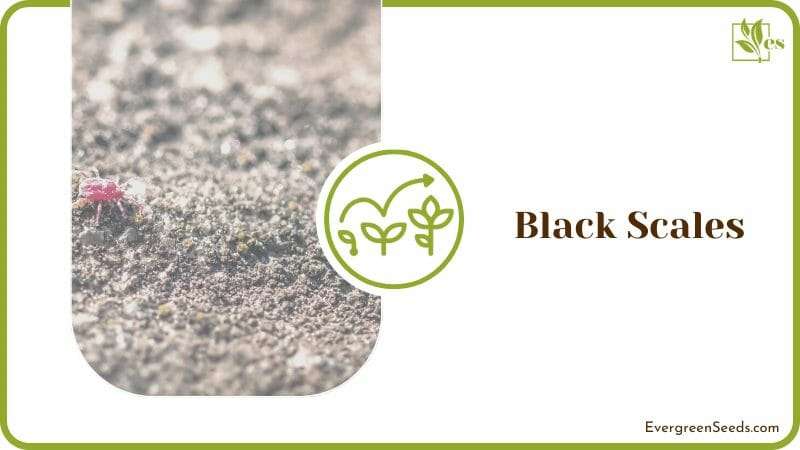 The affected plant will have deformed yellow foliage, experience stunted growth, and the leaves will finally fall off. The black scales also leave honeydew on leaves as well as sooty mold that will be sticky if you touch the foliage and stems.
The affected plant will have deformed yellow foliage, experience stunted growth, and the leaves will finally fall off. The black scales also leave honeydew on leaves as well as sooty mold that will be sticky if you touch the foliage and stems.
Black scales can be difficult to control, especially the armored ones. The hard shell protects the scale insects from the effects of pesticides, so they will not be killed using these. Isopropyl rubbing alcohol seems to be effective in destroying scales.
Soak the cotton swabs into the rubbing alcohol and dab directly onto the scales to destroy the bugs by dissolving their shells.
You can also isolate the infected plant and trim the attacked leaves. It will be easier to kill these tiny black pests as they are always in clusters. So by removing one leaf, you have destroyed hundreds of scales. Scrapping or crushing them with your hands can also work to destroy scales but can be tiresome if there are a lot of attacked plants.
– Black Spider Mites
Black spider mites are also known as soil mites and they can be green, reddish or dark brown. These mites are so tiny that they are less than 0.04 inches long so you may need magnifying glasses to identify them.
These houseplant pests also use their mouthparts to feed on the plant sap. These black mites attack plant foliage the most, so you should check for these tiny black bugs on leaves.
Black spider mites are important as they help to speed up the decomposition process by breaking down the rotting organic matter. These mites are also dangerous as they facilitate the spread of viruses and bacteria as they move from the infected plant to the healthy ones.
The infected plant will have spots, yellow foliage, and webs around it, and if not treated, the leaves will eventually fall off. You can see the black mites creeping on the webbing but because of their size, you need to look closely or have a magnifying glass.
You should isolate the infected plant and wash the black mite pests off the plant with water. Allow the plant to dry before spraying neem oil or insecticidal soap to destroy all the mites and eggs left after washing.
Mix one teaspoon of liquid castile soap, two tablespoons of organic neem oil, and one gallon of water. Use the solution once a week for at least three weeks for effectiveness and make sure that neem oil is not expired.
– Springtails
Springtails are minute hexapod bugs that are found in the soil. These tiny black bugs outlive very low winter temperatures as they are protected by the proteins that are in their bodies.
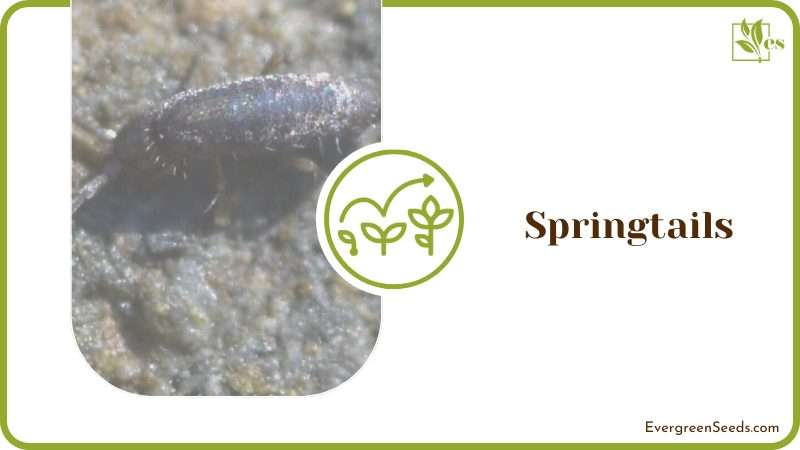 The wingless springtails are 0.03 inches long and they jump to move from one place to another. They like moist spots, so if the soil dries up they move around looking for other places with moisture.
The wingless springtails are 0.03 inches long and they jump to move from one place to another. They like moist spots, so if the soil dries up they move around looking for other places with moisture.
Controlling these tiny pests will only be necessary if they become severe as they usually do not damage your indoor plants. The springtails survive by eating the organic matter in the soil but can feed on plant roots if the soil is wet and acidic.
Add heavily decayed compost up to a depth of six inches into the soil to improve the drainage if the soil is compacted so that it will not retain moisture for too long. You can also implement the soak and dry method when watering to destroy the springtails as they cannot live in a dry potting mix.
When mulching, make sure the layer is less than four inches thick so that the soil dry faster. You can also spray the infected soil with the insecticidal soap solution. Drench the potting mix with the insecticidal soap solution to destroy these tiny bugs in houseplant soil. Mix one tablespoon of the dishwashing liquid with one liter of water to make the solution.
– Black Thrips
Black thrips are tiny, winged slender-bodied bugs that are 0.04 inches long. Houseplants are the most infected plants by this tiny black bug. The leaves will have green or black dots on the undersides because that’s where the insect hides.
If the pests are not controlled in time, the black dots will develop into yellow-like stains and the leaves can start to dry up and then finally die.
The infected plant can stop flowering because of the extensive damage that can be caused by these tiny black bugs. If you suspect black thrips infection, get a sheet of white paper and put it underneath the plant foliage. Gently shake the leaves and if there are any black thrips on your plant, they will fall on the paper. The bugs will appear like black specks.
You can use Spinosad to kill the black thrips because it is fast, natural, and effective. Neem oil and insecticidal soap can also be used to control the black thrips.
The neem oil spray can be used to destroy many different types of bugs and it protects plants from being attacked by pests. The spray will be absorbed by the plants and it will deter the black thrips. Neem oil will leave an odd smell but you can eliminate it.
– Black Aphids
Black aphids are sap-sucking bugs as well. This microscopic black bug has two antennae and six legs. The black aphids can be found on the underside of the leaf and they will be in clusters. The pear-shaped bug can also be seen on leaf veins.
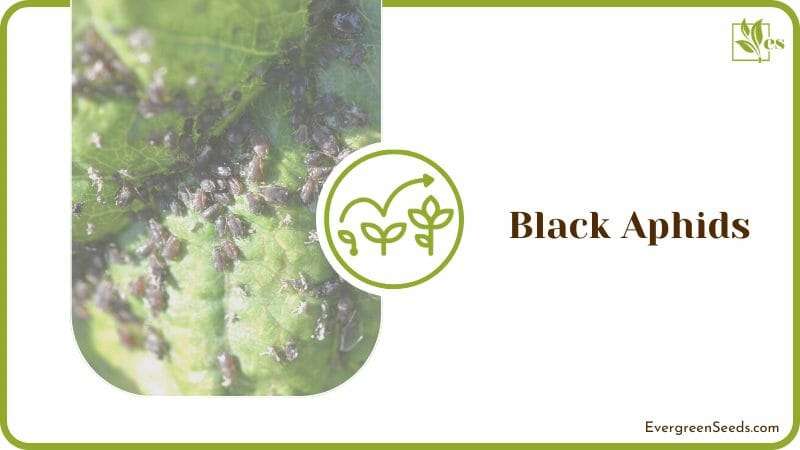 After the black aphid has sucked out the chlorophyll, your plant will have yellow, curled and spotted leaves. The plant can also suffer stunted growth. If you also suspect the presence of black aphids, touch the leaves to see if there is a sticky substance as the bugs produce honeydew.
After the black aphid has sucked out the chlorophyll, your plant will have yellow, curled and spotted leaves. The plant can also suffer stunted growth. If you also suspect the presence of black aphids, touch the leaves to see if there is a sticky substance as the bugs produce honeydew.
The honeydew also facilitates the development of black fungal growth that can be a barrier to photosynthesis.
Use neem oil to kill the tiny black bugs on plant leaves and stems. The oil is also effective in disrupting the life cycle of pests. It will hinder the hatching and larva development process. You can also use a garden hose to spray the black aphids off the plants.
– Flea Beetles
Flea beetles are tiny oval-shaped bugs that are covered with a hard shell. The bugs live in the plants’ soil but can be seen in spring and summer crawling on the plant foliage. The flea beetles affect the tomato plants, vegetables and garden ornamentals.
Flea beetles’ cream larvae are also harmful to your plant as they eat the tubers, plant roots and also saplings’ roots.
Flea beetles feed by chewing the plant leaves, causing the formation of holes in the foliage. That’s why they like newly grown leaves because of their tenderness. Diatomaceous earth (DE) can be used to destroy flea beetles and many other pests. DE is a powdery sedimentary rock that constitutes aquatic fossilized diatoms.
You should use the food-grade diatomaceous to spray on the substrate and plant leaves as it is not toxic to humans. Add two cups of pesticide to one gallon of water and spray, but remember to wear protective clothing to protect your nasal passage and throat as the DE can irritate these body parts.
The water will dry up, leaving sticky powdered substances on your plant. To improve soil drainage, moisture retention and aeration, mix 20 percent DE with 80 percent soil.
– Vine Weevil
Vine weevil is a dark black bug that affects mostly potted plants that are either placed indoors or outdoors. This common houseplant bug is nearly 0.30 inches in size and usually feeds on a variety of ornamental plants.
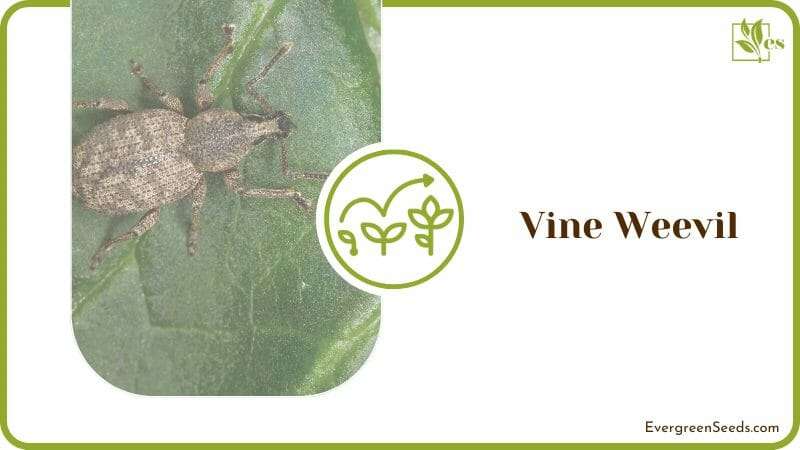 The vine weevils feast on plant foliage, causing notches on leaf margins. The vine weevils are common in summer and they do not cause severe damage to the plants, but the pest can be difficult to control.
The vine weevils feast on plant foliage, causing notches on leaf margins. The vine weevils are common in summer and they do not cause severe damage to the plants, but the pest can be difficult to control.
The vine weevil larva that is white and legless is the one that causes serious damage as it feasts on plant roots, tubers of begonia, and stem bases of most houseplant succulents and cacti.
Once your plants are affected, only stop controlling the vine weevils when you are satisfied that you completely destroyed the larvae as they can reappear again. You can control adult vine weevils by picking them at night because that’s when they feed and you can see them on the plant leaves
You can also use sticky traps. The introduction of predators like frogs, shrews and birds can also be effective in controlling vine weevils. You can also use Bug Clear Ultra Vine Weevil Killer pesticide to kill the vine weevils. The pesticide is applied to the compost in liquid form and it will destroy the vine weevil larvae.
– Leaf Miners
Leaf miners are black flying pests that can cause serious damage to your plant if not controlled in time. The leaf miners’ larvae are the ones that feed on plants by sucking the green pigment in leaves. The larva will bore into the plant leaf and stay inside. When you see squiggly, yellow-like lines on your plant leaves, check for leaf miners.
The plant leaves will also have some blotches once infected. Leaf miners can be treated best at the adult stage of their life cycle, so to know the right time to treat leaf miners, trim a few infected leaves and place them in a bag. Close the bag but remember to check daily for any changes in the larvae.
When the larva has turned into a small black fly, start to use pesticides to kill them. Spray the pesticide daily for a week. You can use neem oil as a natural way of destroying leaf miners, or you can also introduce predators like diglyphus isaea that will effectively control the bugs.












